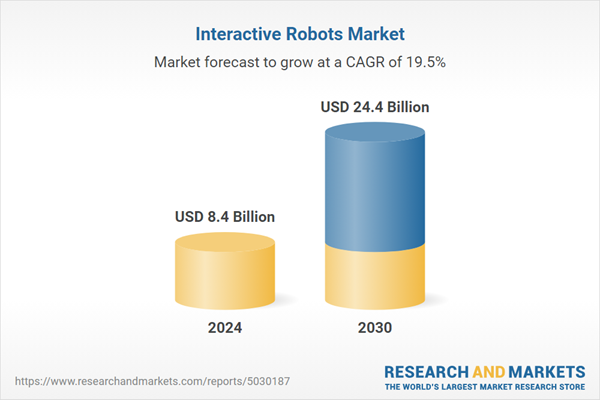The global market for Interactive Robots was valued at US$8.4 Billion in 2024 and is projected to reach US$24.4 Billion by 2030, growing at a CAGR of 19.5% from 2024 to 2030. This comprehensive report provides an in-depth analysis of market trends, drivers, and forecasts, helping you make informed business decisions. The report includes the most recent global tariff developments and how they impact the Interactive Robots market.
The growth in the interactive robots market is driven by several factors. The increasing demand for automation and efficiency in various sectors, including education, healthcare, and customer service, is a major driver, as interactive robots offer scalable and consistent solutions to enhance service delivery. The aging population and rising prevalence of chronic diseases have boosted the need for healthcare robots that can provide care and companionship to the elderly and patients. Additionally, advancements in AI and robotics technologies are making interactive robots more capable and affordable, encouraging wider adoption. The growing trend of smart homes and IoT integration has also spurred demand for interactive robots that can manage and control connected devices, enhancing home automation and convenience. Furthermore, the continuous investment in research and development by tech companies and the increasing interest in robotics by educational institutions are fueling innovations and expanding market opportunities. These factors collectively highlight the dynamic expansion of the interactive robots market, reflecting their critical role in shaping the future of human-robot interaction across various domains.
Technological advancements have significantly enhanced the capabilities and functionalities of interactive robots. Improvements in AI, natural language processing (NLP), and machine learning have enabled these robots to understand and respond to human speech more accurately and contextually. Advanced sensor technologies, including facial recognition and emotion detection, allow robots to perceive and react to human emotions, making interactions more empathetic and engaging. Furthermore, developments in robotics engineering have resulted in more lifelike and versatile designs, with robots capable of performing a wide range of physical tasks. Integration with the Internet of Things (IoT) has also expanded the operational scope of interactive robots, allowing them to interact seamlessly with other smart devices and systems. These technological strides have not only broadened the application areas of interactive robots but also improved their effectiveness and user acceptance.
Segments: Type (Mobile, Stationary); Application (Companion, Humanoid & Assistance; Multimedia, Education & Research; Guidance & Marketing; Hotel Assistance).
Geographic Regions/Countries: World; USA; Canada; Japan; China; Europe; France; Germany; Italy; UK; Rest of Europe; Asia-Pacific; Rest of World.
The analysts continuously track trade developments worldwide, drawing insights from leading global economists and over 200 industry and policy institutions, including think tanks, trade organizations, and national economic advisory bodies. This intelligence is integrated into forecasting models to provide timely, data-driven analysis of emerging risks and opportunities.
Global Interactive Robots Market - Key Trends & Drivers Summarized
Interactive robots, designed to engage and communicate with humans, have rapidly advanced and diversified, finding applications in numerous fields such as education, healthcare, customer service, and entertainment. These robots are equipped with sophisticated sensors, cameras, and artificial intelligence (AI) to interpret and respond to human actions and emotions, making interactions more natural and effective. In education, interactive robots serve as teaching assistants, providing personalized learning experiences and tutoring for students. In healthcare, they assist in therapy and rehabilitation, offering companionship and cognitive stimulation to patients, especially the elderly and those with disabilities. Additionally, in customer service, interactive robots enhance user experiences by providing information, guiding customers, and performing routine tasks, thereby freeing up human staff for more complex responsibilities.The growth in the interactive robots market is driven by several factors. The increasing demand for automation and efficiency in various sectors, including education, healthcare, and customer service, is a major driver, as interactive robots offer scalable and consistent solutions to enhance service delivery. The aging population and rising prevalence of chronic diseases have boosted the need for healthcare robots that can provide care and companionship to the elderly and patients. Additionally, advancements in AI and robotics technologies are making interactive robots more capable and affordable, encouraging wider adoption. The growing trend of smart homes and IoT integration has also spurred demand for interactive robots that can manage and control connected devices, enhancing home automation and convenience. Furthermore, the continuous investment in research and development by tech companies and the increasing interest in robotics by educational institutions are fueling innovations and expanding market opportunities. These factors collectively highlight the dynamic expansion of the interactive robots market, reflecting their critical role in shaping the future of human-robot interaction across various domains.
Technological advancements have significantly enhanced the capabilities and functionalities of interactive robots. Improvements in AI, natural language processing (NLP), and machine learning have enabled these robots to understand and respond to human speech more accurately and contextually. Advanced sensor technologies, including facial recognition and emotion detection, allow robots to perceive and react to human emotions, making interactions more empathetic and engaging. Furthermore, developments in robotics engineering have resulted in more lifelike and versatile designs, with robots capable of performing a wide range of physical tasks. Integration with the Internet of Things (IoT) has also expanded the operational scope of interactive robots, allowing them to interact seamlessly with other smart devices and systems. These technological strides have not only broadened the application areas of interactive robots but also improved their effectiveness and user acceptance.
Report Scope
The report analyzes the Interactive Robots market, presented in terms of units. The analysis covers the key segments and geographic regions outlined below.Segments: Type (Mobile, Stationary); Application (Companion, Humanoid & Assistance; Multimedia, Education & Research; Guidance & Marketing; Hotel Assistance).
Geographic Regions/Countries: World; USA; Canada; Japan; China; Europe; France; Germany; Italy; UK; Rest of Europe; Asia-Pacific; Rest of World.
Key Insights:
- Market Growth: Understand the significant growth trajectory of the Mobile segment, which is expected to reach US$18.4 Billion by 2030 with a CAGR of a 20.5%. The Stationary segment is also set to grow at 16.7% CAGR over the analysis period.
- Regional Analysis: Gain insights into the U.S. market, valued at $2.6 Billion in 2024, and China, forecasted to grow at an impressive 23.5% CAGR to reach $1.9 Billion by 2030. Discover growth trends in other key regions, including Japan, Canada, Germany, and the Asia-Pacific.
Why You Should Buy This Report:
- Detailed Market Analysis: Access a thorough analysis of the Global Interactive Robots Market, covering all major geographic regions and market segments.
- Competitive Insights: Get an overview of the competitive landscape, including the market presence of major players across different geographies.
- Future Trends and Drivers: Understand the key trends and drivers shaping the future of the Global Interactive Robots Market.
- Actionable Insights: Benefit from actionable insights that can help you identify new revenue opportunities and make strategic business decisions.
Key Questions Answered:
- How is the Global Interactive Robots Market expected to evolve by 2030?
- What are the main drivers and restraints affecting the market?
- Which market segments will grow the most over the forecast period?
- How will market shares for different regions and segments change by 2030?
- Who are the leading players in the market, and what are their prospects?
Report Features:
- Comprehensive Market Data: Independent analysis of annual sales and market forecasts in US$ Million from 2024 to 2030.
- In-Depth Regional Analysis: Detailed insights into key markets, including the U.S., China, Japan, Canada, Europe, Asia-Pacific, Latin America, Middle East, and Africa.
- Company Profiles: Coverage of players such as ASUSTeK Computer, Inc., Blue Frog Robotics, Ecovacs Robotics Co., Ltd., Honda Motor Co., Ltd., PAL Robotics SL and more.
- Complimentary Updates: Receive free report updates for one year to keep you informed of the latest market developments.
Some of the 65 companies featured in this Interactive Robots market report include:
- ASUSTeK Computer, Inc.
- Blue Frog Robotics
- Ecovacs Robotics Co., Ltd.
- Honda Motor Co., Ltd.
- PAL Robotics SL
- SoftBank Robotics Group Corp.
- Vstone Co., Ltd.
Tariff Impact Analysis: Key Insights for 2025
Global tariff negotiations across 180+ countries are reshaping supply chains, costs, and competitiveness. This report reflects the latest developments as of April 2025 and incorporates forward-looking insights into the market outlook.The analysts continuously track trade developments worldwide, drawing insights from leading global economists and over 200 industry and policy institutions, including think tanks, trade organizations, and national economic advisory bodies. This intelligence is integrated into forecasting models to provide timely, data-driven analysis of emerging risks and opportunities.
What’s Included in This Edition:
- Tariff-adjusted market forecasts by region and segment
- Analysis of cost and supply chain implications by sourcing and trade exposure
- Strategic insights into geographic shifts
Buyers receive a free July 2025 update with:
- Finalized tariff impacts and new trade agreement effects
- Updated projections reflecting global sourcing and cost shifts
- Expanded country-specific coverage across the industry
Table of Contents
I. METHODOLOGYMII. EXECUTIVE SUMMARY2. FOCUS ON SELECT PLAYERSIII. MARKET ANALYSISIV. COMPETITION
1. MARKET OVERVIEW
3. MARKET TRENDS & DRIVERS
4. GLOBAL MARKET PERSPECTIVE
UNITED STATES
CANADA
JAPAN
CHINA
EUROPE
FRANCE
GERMANY
ITALY
UNITED KINGDOM
REST OF EUROPE
ASIA-PACIFIC
REST OF WORLD
Companies Mentioned (Partial List)
A selection of companies mentioned in this report includes, but is not limited to:
- ASUSTeK Computer, Inc.
- Blue Frog Robotics
- Ecovacs Robotics Co., Ltd.
- Honda Motor Co., Ltd.
- PAL Robotics SL
- SoftBank Robotics Group Corp.
- Vstone Co., Ltd.
Table Information
| Report Attribute | Details |
|---|---|
| No. of Pages | 285 |
| Published | April 2025 |
| Forecast Period | 2024 - 2030 |
| Estimated Market Value ( USD | $ 8.4 Billion |
| Forecasted Market Value ( USD | $ 24.4 Billion |
| Compound Annual Growth Rate | 19.5% |
| Regions Covered | Global |









